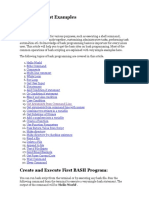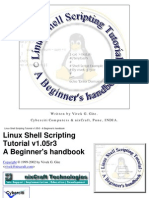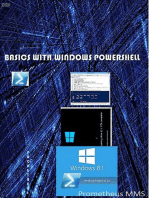Scripting 2
Uploaded by
Sriharsha MajjigaScripting 2
Uploaded by
Sriharsha MajjigaScripting on Linux
Origins of scripting languages Learning scripting languages A simple example of a shell script A script with a loop and debugging Processing a table of data by selecting rows and columns Doing arithmetic internally within the shell Perl, Python, Ruby etc. Scheduling scripted jobs using cron
Origins of scripting languages
Hardwired programs and embedded OS allowed little system control. Job control language JCL allowed IBM mainframe operators to "batch" a sequence of programs into a routine job, e.g. deducting payments made from accounts outstanding.
Benefits: * greater accuracy of job control * less typing * ability to restart job from initial data when system goes down part way through.
Mainframe features reinvented on smaller/cheaper machines.
Command languages developed
TSO/Clist (IBM on-line), PCL (Prime Primos), DCL (DEC VAX/VMS), Aegis (Apollo DomainOS). MS-DOS Batch File (.BAT) etc.
Microsoft froze .BAT language early 1990s. Early versions of MS Basic packaged with MS-DOS, later versions sold separately.
Unix opened development and transfer of ideas between shells. * Bourne Shell: /bin/sh * 'C' Shell: /bin/csh * Korn Shell: /bin/ksh * Ash Shell: /bin/ash * GNU Bash Shell: /bin/sh and /bin/bash Unix shell scripts have usual 3rdG features, including loop constructs, variables, arrays, branches and functions.
Learning scripting languages
Many features shared between shell languages and 'C', Perl, Python etc. The 80/20 rule: 80% of the benefit derives from knowledge of the 20% most useful subset. Programmers learn by: * Reading tutorials, books, reference material * Studying code examples * Running modified code examples * Many small experiments * Knowing how to program using a similar language type
Learning scripting languages 2
Those requiring an in-depth understanding of these languages will need to read the books and on-line tutorials and carry out a comprehensive series of programming exercises.
In other cases a usable subset of knowledge can be obtained by reading the source code of existing programs and executing these, and by conducting small experiments supplemented with tactical use of the reference information provided with languages. Programming knowledge can grow on an as-needed basis.
A simple shell script example
Return values and tests
The Unix shell convention is for a program which exits successfully to end with a return of 0 (which the shell considers true), and for an error exit to result in a return of 1 or more (which the shell considers false). This is the opposite way round to how this is done within 'C'. The number N returned by a program (e.g. using the bash exit N statement) is different from the standard output of the same program. The shell command: echo $?
outputs the return code of the last foreground command.
A script with a loop and debugging
menu script part 2
A table with rows and columns
Here are some records from the may.logins input file:
reboot shutdown usr11361 usr11187 usr11187 usr11187 usr11513 usr11451 usr11456 usr11138 usr12069 usr12069
~ ~ console console console console console console console console console console
Tue May 11 13:14 Tue May 11 13:15 Tue May 11 09:04 - 10:22 (01:18) Mon May 10 18:53 - 20:30 (01:36) Mon May 10 18:50 - 18:53 (00:02) Mon May 10 18:38 - 18:50 (00:12) Mon May 10 15:15 - 16:27 (01:11) Mon May 10 12:11 still logged in Mon May 10 10:53 - 15:14 (04:21) Mon May 10 09:03 - 10:40 (01:36) Sat May 8 11:05 - 09:01 (1+21:55) Sat May 8 11:00 - 11:04 (00:04)
This gives us time logged, one record per login session.
Login analysis script 2
This combines a number of features of previous examples, using awk, grep and sed filters to access specific rows then columns, and to exclude unwanted data from the analysis. The input data is a set of login records. This application was used to analyse average usage of 20 workstations during particular months.
Login analysis script 3
Doing arithmetic internally within the shell
Smaller or earlier Unix shells don't have builtin arithmetic operators, so they farm this job out to external programs such as expr as we saw above. This can be done using the Bash shell let builtin, as in the following example script:
Advanced scripting: Perl, Python, Ruby etc.
Shell scripts provide glue logic together with other utilities, pipelines and redirection.
Advantage: Very rapid development of systems/network administration and automated operations. Disadvantages: Slow, not for very large programs, non-portable. Having to load and execute external programs very many times ?
Adding 200 user login accounts to a system: * Shell: 1 hour to run (1992), helped us learn how to do it * Perl: ('93) 2 minutes to run, we already knew how to do it * 'C' ('94) 6 seconds but 10 times as long to write the program.
Advanced scripting: Perl, Python, Ruby 2
Fully portable languages: Perl, Python and Ruby used to handle simple scripting-type applications or more complex requirements, e.g. object-oriented webapp development. These languages build upon features in shell languages, using similar syntax for many purposes, e.g. handling regular expressions. These languages trade machine for programmer efficiency, compare against 'C', 'C++' . Can combine benefits by using 'C' modules in scripting interpreter or split application design after profiling to find where cycles used.
Advanced scripting: Perl, Python, Ruby 3
The login analysis program described above was rewritten in Perl.
Advanced scripting: Perl, Python, Ruby 4 This program runs much faster than the shell script, because everything is done inside the same process. There are many syntactic similarities, but Perl borrows array and loop notation from 'C' and some other notation from grep, awk and sed. As in Bash, $ is used to introduce single (scalar) variables and @ is used for arrays. $_ is used for a default scalar variable, so that the substitution operation e.g: s/\)//; which strips a closing round bracket from a string, doesn't state the string it modifies.
Scheduling cron jobs on Linux 1
If scripts are the key to systems automation, how do we cause these to be run at set times of the day, or on set days of the week or month ? The program we use for this is called cron.
Cron is a background process which runs other programs at set times. It is controlled using a file called crontab. Crontab contains entries to run all scripts placed in directories: /etc/cron.hourly /etc/cron.daily, /etc/cron.weekly etc.
Scheduling cron jobs on Linux 2
# /etc/crontab: system-wide crontab # Unlike any other crontab you don't have to run the `crontab' # command to install the new version when you edit this file # and files in /etc/cron.d. These files also have username fields, # that none of the other crontabs do.
SHELL=/bin/sh PATH=/usr/local/sbin:/usr/local/bin:/sbin:/bin:/usr/sbin:/usr/bin # m h dom mon dow user command 17 * * * * root cd / && run-parts --report /etc/cron.hourly 25 6 * * * root test -x /usr/sbin/anacron || ( cd / && run-parts --report /etc/cron.daily ) 47 6 * * 7 root test -x /usr/sbin/anacron || ( cd / && run-parts --report /etc/cron.weekly ) 52 6 1 * * root test -x /usr/sbin/anacron || ( cd / && run-parts --report /etc/cron.monthly ) # local modifications # update spam black and whitelist DNS zones every 10 minutes 01,11,21,31,41,51 * * * * root /usr/local/bin/update_dnsfiles # create and email report of weekly spam rejections 22 10 * * 6 root /usr/local/bin/mrejects
You might also like
- C Programming For Beginners: The Simple Guide to Learning C Programming Language Fast!From EverandC Programming For Beginners: The Simple Guide to Learning C Programming Language Fast!5/5 (1)
- How To Install Moshell: 2.3 Installation For Unix (Solaris/Linux)No ratings yetHow To Install Moshell: 2.3 Installation For Unix (Solaris/Linux)4 pages
- Unix Process Control. Linux Tools and The Proc File SystemNo ratings yetUnix Process Control. Linux Tools and The Proc File System89 pages
- L Lpic2213 SystemCustomizationAutomationNo ratings yetL Lpic2213 SystemCustomizationAutomation11 pages
- 16 Optimizing Linux System Performance 7043No ratings yet16 Optimizing Linux System Performance 70435 pages
- Linux - Shell Scripting Tutorial - A Beginner's Handbook100% (2)Linux - Shell Scripting Tutorial - A Beginner's Handbook272 pages
- LPI Exam 201 Prep:: System Customization and AutomationNo ratings yetLPI Exam 201 Prep:: System Customization and Automation11 pages
- Lab 3: Multiprogramming in Nachos: CMSC 442 Due: Monday, Nov. 2 by 11:59:59PmNo ratings yetLab 3: Multiprogramming in Nachos: CMSC 442 Due: Monday, Nov. 2 by 11:59:59Pm6 pages
- Programming Assignment 1: CS 347M Spring 2022No ratings yetProgramming Assignment 1: CS 347M Spring 20228 pages
- Programing Fundamental 1 2 3 4 5 6 7 8 .No ratings yetPrograming Fundamental 1 2 3 4 5 6 7 8 .23 pages
- Lecture 1 Notes: Introduction 1 Compiled Languages and C++No ratings yetLecture 1 Notes: Introduction 1 Compiled Languages and C++9 pages
- Week 1 RedHat Linux Administration & Automation Using Shell ScriptingNo ratings yetWeek 1 RedHat Linux Administration & Automation Using Shell Scripting29 pages
- Lab04 - Introduction To Shell ProgrammingNo ratings yetLab04 - Introduction To Shell Programming7 pages
- UNIT-5 Fundamentals of Information Technology (Question and Answers)No ratings yetUNIT-5 Fundamentals of Information Technology (Question and Answers)15 pages
- Keil C: Submitted by Suraj CR S8 Ec SngceNo ratings yetKeil C: Submitted by Suraj CR S8 Ec Sngce23 pages
- 0.2 - Introduction To Programming Languages - Learn C++No ratings yet0.2 - Introduction To Programming Languages - Learn C++4 pages
- Python Advanced Programming: The Guide to Learn Python Programming. Reference with Exercises and Samples About Dynamical Programming, Multithreading, Multiprocessing, Debugging, Testing and MoreFrom EverandPython Advanced Programming: The Guide to Learn Python Programming. Reference with Exercises and Samples About Dynamical Programming, Multithreading, Multiprocessing, Debugging, Testing and MoreNo ratings yet
- Python for Beginners: An Introduction to Learn Python Programming with Tutorials and Hands-On ExamplesFrom EverandPython for Beginners: An Introduction to Learn Python Programming with Tutorials and Hands-On Examples4/5 (2)
- COMPUTER PROGRAMMING FOR KIDS: An Easy Step-by-Step Guide For Young Programmers To Learn Coding Skills (2022 Crash Course for Newbies)From EverandCOMPUTER PROGRAMMING FOR KIDS: An Easy Step-by-Step Guide For Young Programmers To Learn Coding Skills (2022 Crash Course for Newbies)No ratings yet
- UNIX Shell Scripting Interview Questions, Answers, and Explanations: UNIX Shell Certification ReviewFrom EverandUNIX Shell Scripting Interview Questions, Answers, and Explanations: UNIX Shell Certification Review4.5/5 (4)
- Computer Science: Learn about Algorithms, Cybersecurity, Databases, Operating Systems, and Web DesignFrom EverandComputer Science: Learn about Algorithms, Cybersecurity, Databases, Operating Systems, and Web DesignNo ratings yet
- Dynamic SQL in PL/SQL: Steven FeuersteinNo ratings yetDynamic SQL in PL/SQL: Steven Feuerstein34 pages
- Installation Summary: (Page 5 Onwards) (Page 15 Onwards) (Page 21 Onwards)No ratings yetInstallation Summary: (Page 5 Onwards) (Page 15 Onwards) (Page 21 Onwards)34 pages
- AI For Software Engineering ProductivityNo ratings yetAI For Software Engineering Productivity118 pages
- Intel MKL 2019 Developer Guide Linux PDFNo ratings yetIntel MKL 2019 Developer Guide Linux PDF124 pages
- A-Z Index of The Bash Command Line For LinuxNo ratings yetA-Z Index of The Bash Command Line For Linux5 pages
- Basics On Linux An Commands and Shell ScriptigNo ratings yetBasics On Linux An Commands and Shell Scriptig111 pages
- UNIX - Linux Command To Check Existing Groups and UsersNo ratings yetUNIX - Linux Command To Check Existing Groups and Users4 pages
- Lpi Practicetest 010-160 Vce 2024-Feb-10 by Marshall 60q VceNo ratings yetLpi Practicetest 010-160 Vce 2024-Feb-10 by Marshall 60q Vce7 pages
- C Programming For Beginners: The Simple Guide to Learning C Programming Language Fast!From EverandC Programming For Beginners: The Simple Guide to Learning C Programming Language Fast!
- How To Install Moshell: 2.3 Installation For Unix (Solaris/Linux)How To Install Moshell: 2.3 Installation For Unix (Solaris/Linux)
- Unix Process Control. Linux Tools and The Proc File SystemUnix Process Control. Linux Tools and The Proc File System
- Linux - Shell Scripting Tutorial - A Beginner's HandbookLinux - Shell Scripting Tutorial - A Beginner's Handbook
- LPI Exam 201 Prep:: System Customization and AutomationLPI Exam 201 Prep:: System Customization and Automation
- Lab 3: Multiprogramming in Nachos: CMSC 442 Due: Monday, Nov. 2 by 11:59:59PmLab 3: Multiprogramming in Nachos: CMSC 442 Due: Monday, Nov. 2 by 11:59:59Pm
- Lecture 1 Notes: Introduction 1 Compiled Languages and C++Lecture 1 Notes: Introduction 1 Compiled Languages and C++
- Week 1 RedHat Linux Administration & Automation Using Shell ScriptingWeek 1 RedHat Linux Administration & Automation Using Shell Scripting
- UNIT-5 Fundamentals of Information Technology (Question and Answers)UNIT-5 Fundamentals of Information Technology (Question and Answers)
- 0.2 - Introduction To Programming Languages - Learn C++0.2 - Introduction To Programming Languages - Learn C++
- Python Advanced Programming: The Guide to Learn Python Programming. Reference with Exercises and Samples About Dynamical Programming, Multithreading, Multiprocessing, Debugging, Testing and MoreFrom EverandPython Advanced Programming: The Guide to Learn Python Programming. Reference with Exercises and Samples About Dynamical Programming, Multithreading, Multiprocessing, Debugging, Testing and More
- C# Package Mastery: 100 Essentials in 1 Hour - 2024 EditionFrom EverandC# Package Mastery: 100 Essentials in 1 Hour - 2024 Edition
- Python for Beginners: An Introduction to Learn Python Programming with Tutorials and Hands-On ExamplesFrom EverandPython for Beginners: An Introduction to Learn Python Programming with Tutorials and Hands-On Examples
- COMPUTER PROGRAMMING FOR KIDS: An Easy Step-by-Step Guide For Young Programmers To Learn Coding Skills (2022 Crash Course for Newbies)From EverandCOMPUTER PROGRAMMING FOR KIDS: An Easy Step-by-Step Guide For Young Programmers To Learn Coding Skills (2022 Crash Course for Newbies)
- The Mac Terminal Reference and Scripting PrimerFrom EverandThe Mac Terminal Reference and Scripting Primer
- Learn Python in One Hour: Programming by ExampleFrom EverandLearn Python in One Hour: Programming by Example
- UNIX Shell Scripting Interview Questions, Answers, and Explanations: UNIX Shell Certification ReviewFrom EverandUNIX Shell Scripting Interview Questions, Answers, and Explanations: UNIX Shell Certification Review
- Computer Science: Learn about Algorithms, Cybersecurity, Databases, Operating Systems, and Web DesignFrom EverandComputer Science: Learn about Algorithms, Cybersecurity, Databases, Operating Systems, and Web Design
- Installation Summary: (Page 5 Onwards) (Page 15 Onwards) (Page 21 Onwards)Installation Summary: (Page 5 Onwards) (Page 15 Onwards) (Page 21 Onwards)
- UNIX - Linux Command To Check Existing Groups and UsersUNIX - Linux Command To Check Existing Groups and Users
- Lpi Practicetest 010-160 Vce 2024-Feb-10 by Marshall 60q VceLpi Practicetest 010-160 Vce 2024-Feb-10 by Marshall 60q Vce




































































































